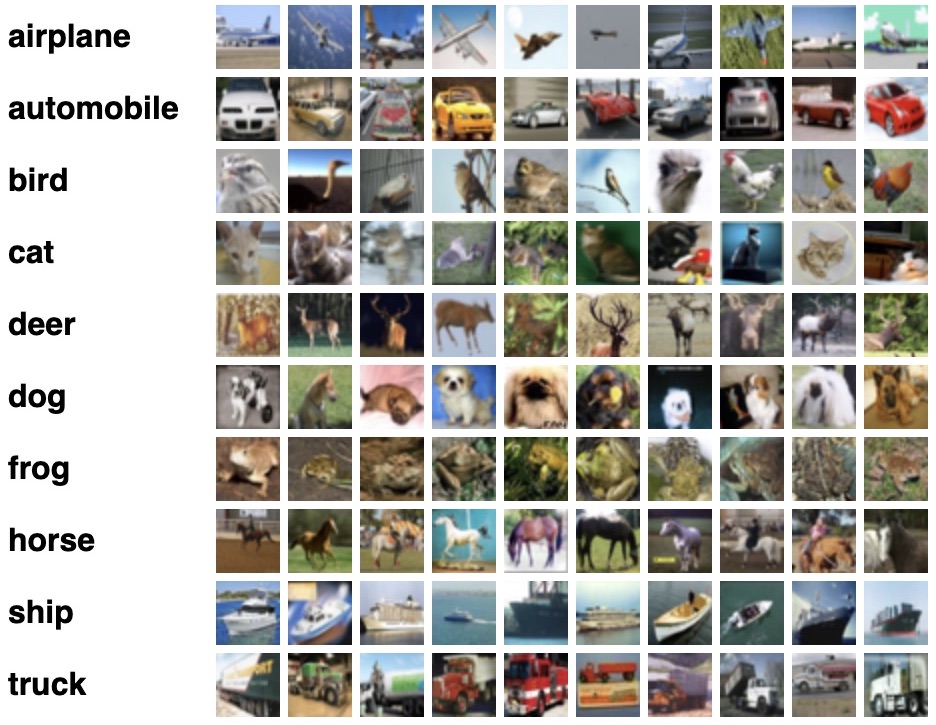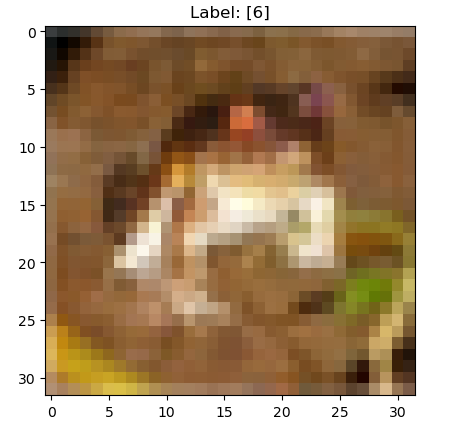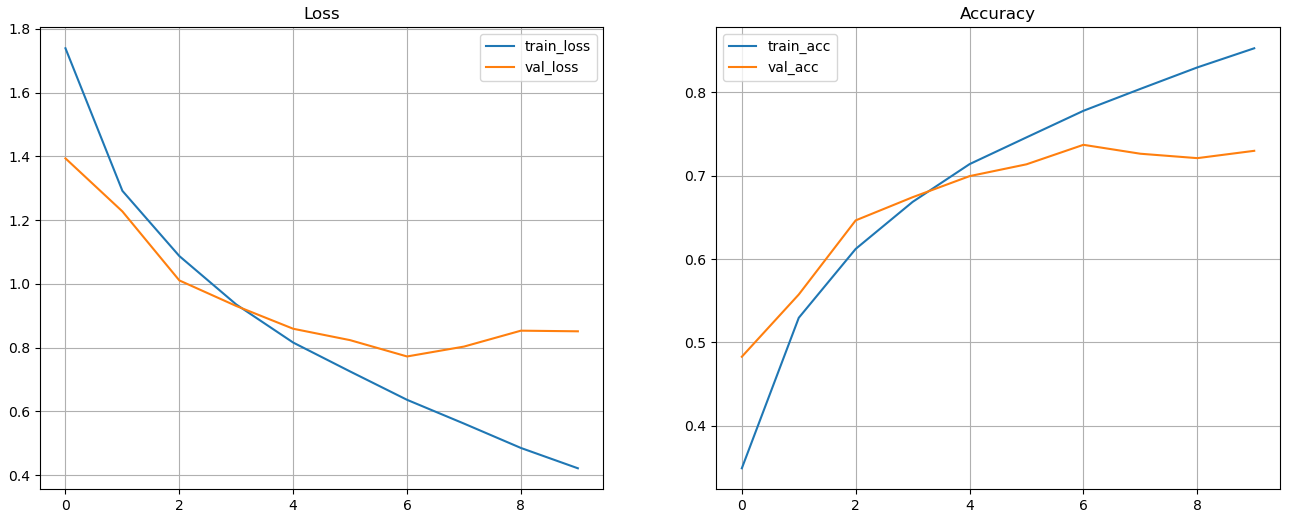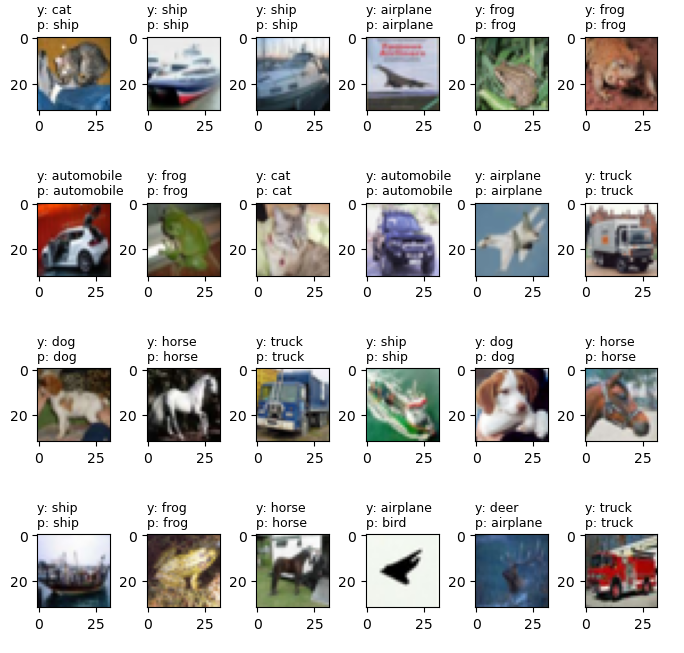6. Deep learning CPU vs GPU
Overview
Questions
- How does the performance of GPU compare with that of CPU?
- How to use Koa to do Machine Learning research?
Objectives
- Do a basic Deep Learning tutorial on Koa
This is a basic image classification tutorial from CIFAR-10 dataset using TensorFlow.
About TensorFlow
TensorFlow is an open source software used in machine learning particularly for training neural networks.
We’ll define our model using ‘Keras’- a high level API which acts as an interface between TensorFlow and Python and makes it easy to build and train models. You can read more about it here.
The CIFAR-10 dataset
CIFAR-10 is a common dataset used for machine learning and computer vision research. It is a subset of 80 million tiny image dataset and consists of 60,000 images. The images are labelled with 10 different classes. So each class has 5000 training images and 1000 test images. Each row represents a color image of 32 x 32 pixels with 3 channels (RGB).

Basic workflow of Machine Learning
- Collect the data
- Pre-process the data
- Define a model
- Train the model
- Evaluate/test the model
- Improve your model
Activity: Work with CIFAR-10 dataset
Exercise: Import dataset, check configuration
To start, import all the relevant libraries:
import numpy as np
import matplotlib.pyplot as plt
import tensorflow as tf
import h5py
import keras
from keras.datasets import cifar10
from tensorflow.keras.models import Sequential
from tensorflow.keras.layers import Dense, Conv2D, Flatten, MaxPooling2D, Input, InputLayer, Dropout
from tensorflow.keras.utils import to_categorical
%matplotlib inline
Next, check to see if you’re using the GPU:
tf.config.list_physical_devices('GPU')
Now, how would you check to see if you’re using the CPU rather than the GPU?
Solution
tf.config.list_physical_devices('CPU')
Is GPU necessary for machine learning?
No, machine learning algorithms can be deployed using CPU or GPU, depending on the applications. They both have their distinct properties and which one would be best for your application depends on factors like: speed, power usage and cost.
CPUs are more general purposed processors, are cheaper and provide a gateway for data to travel from source to GPU cores.
But GPU have an advantage to do parallel computing when dealing with large datasets, complex neural network models. The difference between the two lies in basic features of a processor i.e. cache, clock speed, power consumption, bandwidth and number of cores.
Read more that here.
Exercise: Load the data and analyze its shape
- Load the CIFAR-10 data into training and validation datasets
- Print the size of training dataset, showing how many images (‘X’) and labels (‘y’) it contains
- Print the size of validation datasets, showing how many images (‘X’) and labels (‘y’) it contains
- Calculate and print the number of unique categories (‘classes’) in training data
(x_train, y_train), (x_valid, y_valid) = cifar10.load_data()
print('Train: X=%s, y=%s' % (x_train.shape, y_train.shape))
print('Test: X=%s, y=%s' % (x_valid.shape, y_valid.shape))
print('number of classes= %s' %len(set(y_train.flatten())))
print(type(x_train))
Solution
Downloading data from https://www.cs.toronto.edu/~kriz/cifar-10-python.tar.gz 170498071/170498071 [==============================] - 7s 0us/step Train: X=(50000, 32, 32, 3), y=(50000, 1) Test: X=(10000, 32, 32, 3), y=(10000, 1) number of classes= 10 <class 'numpy.ndarray'> "Train: X=(50000, 32, 32, 3), y=(50000, 1)" shows that in the training dataset: - There are 50000 data points or "images" - Each image has 32 width in pixels, 32 length in pixels, 3 color channels (RGB) - 50000 rows each containing a single label or "class" - The number of unique classes is 10 We can confirm this from the description of the CIFAR-10 dataset from earlier!
Exercise: Print and display one data point
First, let’s print out the first data point’s values in the training dataset to see what it looks like:
i = 0
print(f"Data Point {i + 1}:")
print("Image Data:")
print(x_train[i])
print("Label:")
print(y_train[i])
Solution
Data Point 1: Image Data: [[[ 59 62 63] [ 43 46 45] [ 50 48 43] ... [158 132 108] [152 125 102] [148 124 103]] [[ 16 20 20] [ 0 0 0] [ 18 8 0] ... [123 88 55] [119 83 50] [122 87 57]] [[ 25 24 21] [ 16 7 0] [ 49 27 8] ... [118 84 50] [120 84 50] [109 73 42]] ... [[208 170 96] [201 153 34] [198 161 26] ... [160 133 70] [ 56 31 7] [ 53 34 20]] [[180 139 96] [173 123 42] [186 144 30] ... [184 148 94] [ 97 62 34] [ 83 53 34]] [[177 144 116] [168 129 94] [179 142 87] ... [216 184 140] [151 118 84] [123 92 72]]] Label: [6]
Then we can print the image from that data point, which should be an image with the associated label:
i = 0
plt.figure()
plt.imshow(x_train[i])
plt.title(f"Label: {y_train[i]}")
plt.show()
Solution

Plot some examples
First, specify classes from the CIFAR-10 dataset:
nb_classes = 10
class_names = ['airplane', 'automobile', 'bird', 'cat', 'deer', 'dog', 'frog', 'horse', 'ship', 'truck']
Then plot some samples:
- Create a new figure to plot with a size of 8x8 inches
- Initiate a loop that will repeat 14 times,
(2*7) - Define a subplot within the grid, positioning it in a 2x7 grid layout, increasing
ifor each iteration - Display image at
x_train[i]in the subplot - Assign
class_indexthe category from the labely_train[i]after converting it to a one-hot encoded format - Set the title of the current subplot to the class name determined from
class_indexwith a font size of 9
plt.figure(figsize=(8, 8))
for i in range(2*7):
# define subplot
plt.subplot(2, 7, i+1)
plt.imshow(x_train[i])
class_index = np.argmax(to_categorical(y_train[i], 10))
plt.title(class_names[class_index], fontsize=9)
Solution

Check TensorFlow version
tf.__version__
Solution
For what we are currently using it should output: '2.10.0'Exercise: Convert data to HDF5 format
with h5py.File('dataset_cifar10.hdf5', 'w') as hf:
dset_x_train = hf.create_dataset('x_train', data=x_train, shape=(50000, 32, 32, 3), compression='gzip', chunks=True)
dset_y_train = hf.create_dataset('y_train', data=y_train, shape=(50000, 1), compression='gzip', chunks=True)
dset_x_test = hf.create_dataset('x_valid', data=x_valid, shape=(10000, 32, 32, 3), compression='gzip', chunks=True)
dset_y_test = hf.create_dataset('y_valid', data=y_valid, shape=(10000, 1), compression='gzip', chunks=True)
What is an HDF5 file?
HDF5 file format is a binary data format which is mainly used to store large, heterogenous files. It provides fast, parallel I/O processing.
Exercise: Define the model
Here, we are creating a sequential model and adding a series of different layers such as convolutional layers and maxpooling layers sequentially to define the structure of this neural network and then outputting it’s summary
model = tf.keras.Sequential()
model.add(InputLayer(input_shape=[32, 32, 3]))
model.add(Conv2D(filters=32, kernel_size=3, padding='same', activation='relu'))
model.add(MaxPooling2D(pool_size=[2,2], strides=[2, 2], padding='same'))
model.add(Conv2D(filters=64, kernel_size=3, padding='same', activation='relu'))
model.add(MaxPooling2D(pool_size=[2,2], strides=[2, 2], padding='same'))
model.add(Conv2D(filters=128, kernel_size=3, padding='same', activation='relu'))
model.add(MaxPooling2D(pool_size=[2,2], strides=[2, 2], padding='same'))
model.add(Conv2D(filters=256, kernel_size=3, padding='same', activation='relu'))
model.add(MaxPooling2D(pool_size=[2,2], strides=[2, 2], padding='same'))
model.add(Flatten())
model.add(Dense(256, activation='relu'))
model.add(Dropout(0.2))
model.add(Dense(512, activation='relu'))
model.add(Dropout(0.2))
model.add(Dense(10, activation='softmax'))
model.summary()
Exercise: Define the data generator
Define a data generator python class that prepares batches of data for training or testing deep learning models which allows for efficient handling of large datasets and data augmentation
class DataGenerator(tf.keras.utils.Sequence):
def __init__(self, filename, batch_size, test=False, shuffle=True):
self.PATH_TO_FILE = filename
self.hf = h5py.File(self.PATH_TO_FILE, 'r')
self.batch_size = batch_size
self.test = test
self.shuffle = shuffle
self.on_epoch_end()
def __del__(self):
self.hf.close()
def __len__(self):
return int(np.ceil(len(self.indices) / self.batch_size))
def __getitem__(self, idx):
start = self.batch_size * idx
stop = self.batch_size * (idx+1)
if self.test:
x = self.hf['x_valid'][start:stop, ...]
batch_x = np.array(x).astype('float32') / 255.0
y = self.hf['y_valid'][start:stop]
batch_y = to_categorical(np.array(y), 10)
else:
x = self.hf['x_train'][start:stop, ...]
batch_x = np.array(x).astype('float32') / 255.0
y = self.hf['y_train'][start:stop]
batch_y = to_categorical(np.array(y), 10)
return batch_x, batch_y
def on_epoch_end(self):
if self.test:
self.indices = np.arange(self.hf['x_valid'][:].shape[0])
else:
self.indices = np.arange(self.hf['x_train'][:].shape[0])
if self.shuffle:
np.random.shuffle(self.indices)
Exercise: Generate batches of data for training and validation dataset
filename = "dataset_cifar10.hdf5"
batchsize = 250
data_train = DataGenerator(filename, batch_size=batchsize, test=False)
data_valid = DataGenerator(filename, batch_size=batchsize, test=True, shuffle=False)
Exercise: Define optimizer for the model
model.compile(optimizer='adam', loss='categorical_crossentropy', metrics=['accuracy'])
Exercise: First, let’s train the model using CPU
with tf.device('/device:CPU:0'):
history = model.fit(data_train,epochs=2,
verbose=1, validation_data=data_valid)
Exercise: Now, let’s compare GPU to CPU performance.
First, let’s get the CPU performance data.
from tensorflow.keras.models import clone_model
new_model = clone_model(model)
opt = keras.optimizers.Adam(learning_rate=0.001)
new_model.compile(optimizer=opt, loss='categorical_crossentropy', metrics=['accuracy'])
Exercise: Train the new model with GPU
Can you do this yourself?
Solution
with tf.device('/device:GPU:0'):
new_history = new_model.fit(data_train,epochs=10, verbose=1, validation_data=data_valid)
Exercise: Plot the losses and accuracy for training and validation set
# plotting the losses and accuracy for training and validation set using CPU
fig, axes = plt.subplots(1,2, figsize=[16, 6])
axes[0].plot(history.history['loss'], label='train_loss')
axes[0].plot(history.history['val_loss'], label='val_loss')
axes[0].set_title('Loss')
axes[0].legend()
axes[0].grid()
axes[1].plot(history.history['accuracy'], label='train_acc')
axes[1].plot(history.history['val_accuracy'], label='val_acc')
axes[1].set_title('Accuracy')
axes[1].legend()
axes[1].grid()
Solution

Exercise: Evaluate the model and make predictions
# evaluate the model
x = x_valid.astype('float32') / 255.0
y = to_categorical(y_valid, 10)
score = model.evaluate(x, y, verbose=0)
print('Test cross-entropy loss: %0.5f' % score[0])
print('Test accuracy: %0.2f' % score[1])
# make predictions on the model
y_pred=model.predict(x)
y_pred_classes=np.argmax(y_pred,axis=1)
Exercise: Plot the predictions
plt.figure(figsize=(8, 8))
for i in range(24):
plt.subplot(4, 6, i+1)
plt.imshow(x[i].reshape(32,32,3))
index1 = np.argmax(y[i])
plt.title("y: %s\np: %s" % (class_names[index1], class_names[y_pred_classes[i]]), fontsize=9, loc='left')
plt.subplots_adjust(wspace=0.5, hspace=0.4)
Solution

Exercise: Plot the losses and accuracy for training and validation set for GPU
# plotting the losses and accuracy for training and validation set using GPU
fig, axes = plt.subplots(1,2, figsize=[16, 6])
axes[0].plot(new_history.history['loss'], label='train_loss')
axes[0].plot(new_history.history['val_loss'], label='val_loss')
axes[0].set_title('Loss')
axes[0].legend()
axes[0].grid()
axes[1].plot(new_history.history['accuracy'], label='train_acc')
axes[1].plot(new_history.history['val_accuracy'], label='val_acc')
axes[1].set_title('Accuracy')
axes[1].legend()
axes[1].grid()
Solution

Exercise: Evaluate the model and make predictions again
# evaluate the new_model
x = x_valid.astype('float32') / 255.0
y = to_categorical(y_valid, 10)
score = new_model.evaluate(x, y, verbose=0)
print('Test cross-entropy loss: %0.5f' % score[0])
print('Test accuracy: %0.2f' % score[1])
# make predictions on the new_model
y_pred=new_model.predict(x)
y_pred_classes=np.argmax(y_pred,axis=1)
Exercise: Plot the predictions again
plt.figure(figsize=(8, 8))
for i in range(24):
plt.subplot(4, 6, i+1)
plt.imshow(x[i].reshape(32,32,3))
index1 = np.argmax(y[i])
plt.title("y: %s\np: %s" % (class_names[index1], class_names[y_pred_classes[i]]), fontsize=9, loc='left')
plt.subplots_adjust(wspace=0.5, hspace=0.4)
Solution

Exercise: Looking at the predictions side by side
Left: CPU prediction on the model, right: GPU prediction on the new model


Other Machine Learning resources
- You can use Google Colab which uses Jupyter notebooks too but on Google server. Here you can get free limited compute resources (even GPU) and upgrade your account (for TPU) if you want more. The code usually runs on Google servers on cloud and is connected to your google account so all your projects will be saved in your Google Drive.
- Microsoft Azure notebook is similar to Google Colab with cloud sharing functionality but provides more memory.
- Kaggle
- Amazon Sage Maker
Key Points
- JupyterLab is a more common platform for data science research but there are other IDE (Integrated Development Environment softwares) like PyCharm, Spyder, RMarkdown too.
- Using multiple GPUs won’t improve the performance of your machine learning model. It only helps for a very complex computation or large models.